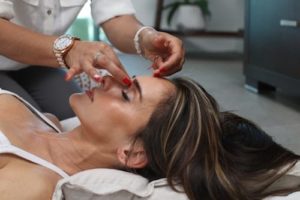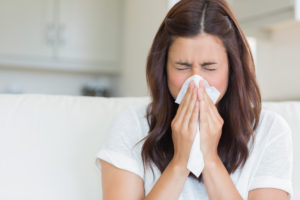Sinusitis vs. Allergies
 Many individuals are unsure whether they have sinusitis (i.e., sinus infection) vs. typical “allergies.” Sinusitis generally refers to infected sinuses, however, sinusitis technically means “inflammation of the sinuses.” Typically, sinusitis is a direct result of either a “cold” or allergies (i.e., allergic rhinitis, hay fever). The symptoms of each condition are usually very similar and the differences can be very subtle, however there are several things to look at in order to help differentiate between the two disorders. In both allergic rhinitis and sinusitis, most patients will experience one or more of the following symptoms: nasal congestion, runny nose, post-nasal drip, sneezing, itchy eyes, and/or watery eyes. Patients with sinusitis, however, may also experience one or more of the following symptoms in addition to the symptoms above: sinus headaches, thick discolored mucus from the nose, sore throat, cough, sinus pressure, teeth pain (particularly the upper teeth), fatigue, malodorous breath, decreased sense of taste/smell, and/or mild fever.
Many individuals are unsure whether they have sinusitis (i.e., sinus infection) vs. typical “allergies.” Sinusitis generally refers to infected sinuses, however, sinusitis technically means “inflammation of the sinuses.” Typically, sinusitis is a direct result of either a “cold” or allergies (i.e., allergic rhinitis, hay fever). The symptoms of each condition are usually very similar and the differences can be very subtle, however there are several things to look at in order to help differentiate between the two disorders. In both allergic rhinitis and sinusitis, most patients will experience one or more of the following symptoms: nasal congestion, runny nose, post-nasal drip, sneezing, itchy eyes, and/or watery eyes. Patients with sinusitis, however, may also experience one or more of the following symptoms in addition to the symptoms above: sinus headaches, thick discolored mucus from the nose, sore throat, cough, sinus pressure, teeth pain (particularly the upper teeth), fatigue, malodorous breath, decreased sense of taste/smell, and/or mild fever.
When someone develops a sinus infection, it may be acute, chronic, or recurrent:
Acute sinusitis is the most common form of sinusitis. It is the classic example of a sinus infection. Individuals typically will complain of sinus or facial pressure, headaches, nasal congestion, thick discolored nasal mucus, post-nasal drip with or without a sore throat, and/or cough. Patients often will say that they had a “cold” before the sinus infection began. Others will give a history of being exposed to something that they were allergic to such as pets, pollens, dust, etc. The treatment may entail the use of antibiotics (generally if the symptoms have been present for more than 1 week), nasal corticosteroids, antihistamines, decongestants, and/or mucolytics (i.e., mucus thinners). It should be noted that most cases of acute sinusitis are caused by viruses and thus antibiotics are not necessary. If the symptoms persist and/or get worse, however, antibiotics are often used.
Chronic sinusitis is not as common as acute sinusitis, but is generally more difficult to treat. An allergist should suspect chronic sinusitis when the patient has had symptoms for a long time, a sinus infection is recurrent, and/or fatigue becomes more prevalent. The symptoms of chronic sinusitis may include all of the symptoms found with acute sinusitis except a fever is less common with chronic sinusitis. In addition to the symptoms found in acute sinusitis, patients with chronic sinusitis may exhibit a decreased sense of taste/smell, fatigue, malodorous breath, and/or cough. The cough tends to be a “barky” cough, although any cough may occur. The diagnosis of chronic sinusitis is usually verified by a CT scan of the sinuses. It will show thickened mucus membranes of the sinuses compared with an “air-fluid level” found in patients with acute sinusitis. In addition to using antihistamines, nasal corticosteroids, decongestants, and/or mucolytics, the treatment of chronic sinusitis generally involves a 30 day course of antibiotics. If the infection is recalcitrant, another 30 day course of an antibiotic may be necessary. In some individuals, sinus surgery may be necessary in order to eradicate the infection. The surgical procedure may also be directed at creating better drainage of the sinuses, in order to help prevent future sinus infections.
Recurrent sinusitis is actually repetitive acute sinus infections. They can occur for a variety of reasons, some of which are as follows:
1.) If an acute sinus infection is not completely eradicated, the focus of the bacterial infection remains, and the bacteria may grow back causing another acute sinus infection.
2.) The wrong antibiotic or an antibiotic that the bacteria is not as sensitive to may cause a sinus infection to return.
3.) Allergic patients that have been exposed and re-exposed to large amounts of allergen(s) can develop recurrent sinus infections.
4.) Re-exposure to different viruses may cause recurrent sinusitis
5.) Individuals with immune dysfunctions may develop recurrent sinusitis.
It is important to note that many individuals think that they are experiencing recurrent sinus infections, when in fact they have an indolent chronic sinus infection with intermittent worsening symptoms. This gives the patient the false impression that they are getting recurrent acute sinus infections. It takes a board certified allergist in order to realize that the individual may have a chronic sinus infection instead of recurrent infections, as the treatment of the 2 conditions is very different. The treatment of recurrent sinusitis is essentially the same as that of an acute sinus infection.
The board certified allergists at Black & Kletz Allergy have expertise in diagnosing and treating all types of sinus infections, as well as all types of allergic conditions and asthma. We are board certified to treat both adult and pediatric patients and have been doing so in the Washington, DC, Northern Virginia, and Maryland metropolitan area for more than a half a century. Black & Kletz Allergy has offices in Washington, DC, McLean, VA (Tysons Corner, VA), and Manassas, VA. All 3 of our offices have on-site parking. For further convenience, our Washington, DC and McLean, VA offices are Metro accessible. Our McLean office location offers a complementary shuttle that runs between our office and the Spring Hill metro station on the silver line. For an appointment, please call our office or alternatively, you can click Request an Appointment and we will respond within 24 hours by the next business day. If you suffer from allergies and/or sinus-related symptoms, we are here to help alleviate or hopefully end these unwanted symptoms that have been so bothersome, so that you can enjoy a better quality of life. Black & Kletz Allergy is dedicated to providing the highest quality allergy care in a relaxed, caring, and professional environment.






